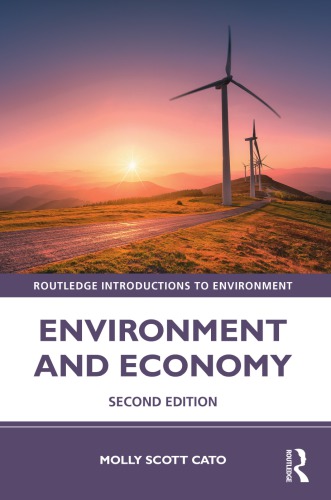

Most ebook files are in PDF format, so you can easily read them using various software such as Foxit Reader or directly on the Google Chrome browser.
Some ebook files are released by publishers in other formats such as .awz, .mobi, .epub, .fb2, etc. You may need to install specific software to read these formats on mobile/PC, such as Calibre.
Please read the tutorial at this link. https://ebooknice.com/page/post?id=faq
We offer FREE conversion to the popular formats you request; however, this may take some time. Therefore, right after payment, please email us, and we will try to provide the service as quickly as possible.
For some exceptional file formats or broken links (if any), please refrain from opening any disputes. Instead, email us first, and we will try to assist within a maximum of 6 hours.
EbookNice Team

Status:
Available4.8
16 reviews(Ebook) Environment And Economy 2nd Edition by Molly Scott Cato - Ebook PDF Instant Download/Delivery: 9780367183028, 0367183021
Full download (Ebook) Environment And Economy 2nd Edition after payment

Product details:
ISBN 10: 0367183021
ISBN 13: 9780367183028
Author: Molly Scott Cato
(Ebook) Environment And Economy 2nd Edition Table of contents:
Part I Setting the scene
1 Introduction: an economy within the environment
1.1 Environment and economy: friends or foes?
1.2 Complementarities and tensions within the economy–environment relationship
1.3 Economics and environment: some useful concepts
1.4 The environment in early thinking about economics
1.5 A tale of many traditions
Summary questions
Discussion questions
2 The whistle-blowers
2.1 Kenneth Boulding and spaceship earth
2.2 The Club of Rome
2.3 Ehrlich and The Population Bomb
2.4 E. F. Schumacher and small is beautiful
2.5 Howard Odum: thinking in systems
2.6 Murray Bookchin: prophet of localization
2.7 Hazel Henderson attacks the snake-oil doctors
Summary questions
Discussion questions
Part II Economic schools and the environment
3 Neoclassical economics
3.1 Markets, efficient allocation and assessing outcomes
3.2 Price, scarcity and substitutability
3.3 The environment begins to impinge on the economics profession
3.4 Discounting the future
3.5 Case study: Putting a price on carbon – the EU Emissions Trading Scheme
Summary questions
Discussion questions
Notes
Further reading
4 Environmental economics
4.1 Economics with the environment at its heart
4.2 Valuing the environment
Market pricing techniques
Household production functions
Hedonic price methods
Experimental methods
4.3 When will we be rich enough to save the planet?
4.4 Can markets save the planet?
4.5 Case study: How much do you like to be beside the seaside?
Summary questions
Discussion questions
Note
Further reading
5 Ecological economics
5.1 A break with tradition
5.2 Thinking differently about the economy
The contribution of ecology
Systems thinking and thermodynamics
Extending the concept of capital
5.3 From equilibrium to steady state
5.4 Case study: Pricing the priceless?
Summary questions
Discussion questions
Notes
Further reading
6 Green economics
6.1 An economy with soul
6.2 An alternative to capitalism that isn’t communism
6.3 Policies to create a green economy
6.4 Ecotopias in the here and now
6.5 Case study: Universal basic income – an idea whose time has come?
Summary questions
Discussion questions
Further reading
7 Anti-capitalist economics
7.1 Capitalism, nature, socialism
7.2 Re-including the excluded
7.3 Changing the world
7.4 Case study: A participatory approach to the allocation of money and goods
Summary questions
Discussion questions
Note
Further reading
Part III Issues and policies
8 A range of policy approaches
8.1 How much change and who should make it?
8.2 Regulation or incentive-based instruments?
8.3 Measurement issues
8.4 Cultural and behavioural change
8.5 Case study: From linear to circular economy
Summary questions
Discussion questions
Further reading
9 Economic growth
9.1 Growth is good
9.2 The threat from growth and the steady-state economy
9.3 Measurement and efficiency
9.4 Link between growth and inequality
9.5 From quantity to quality
9.6 Case study: Growth or well-being – how to measure economic success
Summary questions
Discussion questions
Note
Further reading
10 Climate change: the greatest example of market failure?
10.1 The most serious issue of our time
10.2 The Stern Review: an economist encounters the environment
10.3 Pricing carbon: theory and consequent policies
10.4 How to act in a climate emergency
10.5 Case study: Land, food and farming in a climate emergency
Summary questions
Discussion questions
Further reading
11 All that the earth provides: the economics of resources
11.1 A science of scarcity
11.2 Using prices to protect natural resources
11.3 The planet sold to service our desires
11.4 Scarcity or abundance
11.5 Case study: Fisheries policy
Summary questions
Discussion questions
Further reading
12 Pollution
12.1 Neoclassical economics: internalizing the externality
12.2 Negotiating shared political action
12.3 Working with nature to minimize pollution
12.4 One man’s meat is another man’s poison
12.5 Case study: The scourge of plastic pollution
Summary questions
Discussion questions
Further reading
13 Globalization vs. localization
13.1 All aboard the globalization rollercoaster
13.2 Global sceptics
13.3 From globalization to the bioregional economy
13.4 Case study: A UN binding treaty to protect human rights in the face of corporate power
Summary questions
Discussion questions
Further reading
14 Markets or commons
14.1 Markets and property rights as the best protection
14.2 Common rights and livelihoods
14.3 Back to the future
14.4 Case study: Land struggles in Brazil
Summary questions
Discussion questions
Further reading
15. Conclusion: Is it the economy? Are we stupid?
15.1 Too clever for our own good?
15.2 Putting the market in its place?
15.3 Whose common future?
15.4 An oversupply of bad news?
15.5 It’s your future; it’s your choice
Summary questions
Discussion questions
Note
Further reading
Glossary
Bibliography
Index
People also search for (Ebook) Environment And Economy 2nd Edition:
pollution and economic growth
impact of air pollution on the environment and economy
positive impacts of volcanoes on people/environment and economy
environment and development economics publication fee
economic environment explain
Tags: Molly Scott Cato, Environment, Economy